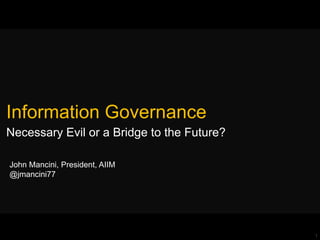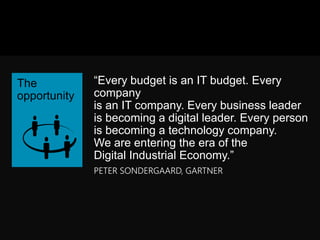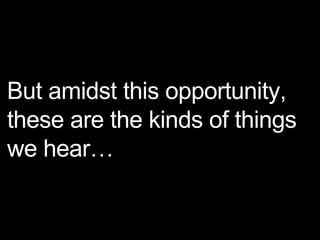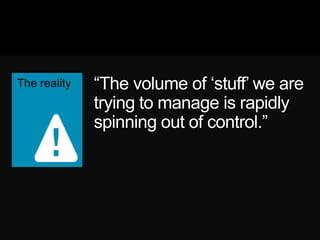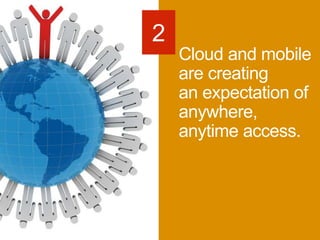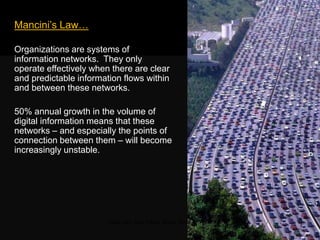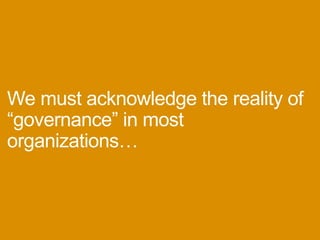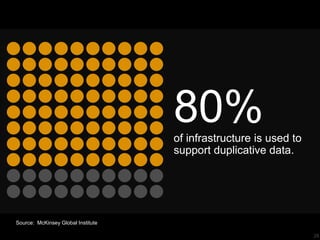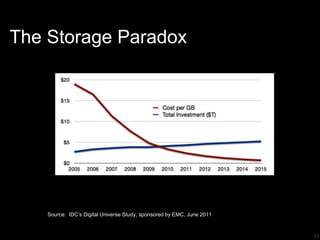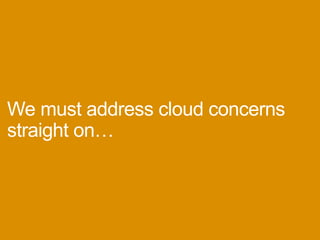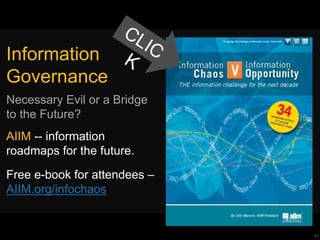Information Governance -- Necessary Evil or a Bridge to the Future?
- 1. 1 Information Governance Necessary Evil or a Bridge to the Future? John Mancini, President, AIIM, AIIM.org @jmancini77
- 2. 2 ‣ What AIIM does: • We build information management roadmaps to help organizations turn Information Chaos into Information Opportunity.
- 3. 3 ‣ Thank you for the insights of Jason Baron, Else Khoury, Nick Inglis and Rich Medina at #AIIM14, which I found helpful and have tried to capture in this presentation.
- 4. 4 How the world is changing Old paradigms are being stretched to the breaking point How we usually think about governance It‘s not just about what you keep How should we respond? Building an action plan for the next 2-3 years 1 2 3
- 5. Information is the world‘s new currency
- 6. ―Every budget is an IT budget. Every company is an IT company. Every business leader is becoming a digital leader. Every person is becoming a technology company. We are entering the era of the Digital Industrial Economy.‖ PETER SONDERGAARD, GARTNER
- 8. ―Our file servers are out of control and no one can find anything.‖
- 9. ―Information is leaking out of the organization at every turn via devices that weren‘t even invented when we put our systems in place.‖
- 10. ―The volume of ‗stuff‘ we are trying to manage is rapidly spinning out of control.‖
- 11. ―Maximizing our SharePoint investment is proving more difficult than we thought.‖
- 12. ―Every time I turn around, ‗the business‘ has implemented some new application that we didn‘t even know about in IT.‖
- 13. ―As the CEO, I can‘t believe we are not getting more value out of the money we spend on technology.‖
- 14. Welcome to the era of
- 16. Consumerization is transforming what users expect from applications and how we deliver them.
- 17. The four drivers of consumerization A programming language and SDK A friction free distribution platform
- 18. Cloud and mobile are creating an expectation of anywhere, anytime access.
- 19. ―IT cost savings and speedier deployment are but a brief prelude to the main story. It‘s only the first 10 percent. The remaining 90 percent is what happens to the business itself.‖ ―In 45 seconds, you can go from never having heard a song to owning it. This is the era of collapsing purchase cycles.‖
- 20. The future is flat and agile, not hierarchical and slow.
- 23. Mancini‘s Law… Organizations are systems of information networks. They only operate effectively when there are clear and predictable information flows within and between these networks. Traffic jam, Sao Paolo, Brazil, 2009
- 24. Mancini‘s Law… Organizations are systems of information networks. They only operate effectively when there are clear and predictable information flows within and between these networks. 50% annual growth in the volume of digital information means that these networks – and especially the points of connection between them – will become increasingly unstable. Traffic jam, Sao Paolo, Brazil, 2009
- 25. Mancini‘s Law… Organizations are systems of information networks. They only operate effectively when there are clear and predictable information flows within and between these networks. 50% annual growth in the volume of digital information means that these networks – and especially the points of connection between them – will become increasingly unstable. Without intervention, the resulting #infochaos will threaten the viability of the entire system. Traffic jam, Sao Paolo, Brazil, 2009
- 26. 26 How the world is changing Old paradigms are being stretched to the breaking point How we usually think about governance It‘s not just about what you keep How should we respond? Building an action plan for the next 2-3 years 1 2 3
- 28. 28 80%of infrastructure is used to support duplicative data. Source: McKinsey Global Institute
- 29. 29 75%of IT budget is used for infrastructure maintenance. Source: Gartner
- 30. 30 $18,000 = eDiscovery cost for 1GB of data Source: RAND study on eDiscovery, 2012
- 31. ‣ Information Inflation ‣ Lehman Brothers Investigation • 350 billion page universe (3 petabytes) • Examiner narrowed collection by selecting key custodians, using dozens of Boolean searches • Reviewed 5 million docs (40 million pages using 70 contract attorneys) 31 Original Reference: Presentation by Jason R. Baron, Drinker Biddle & Reath LLP, at AIIM14 Jason‘s Source: Report of Anton R. Valukas, Examiner, In re Lehman Brothers Holdings Inc., et al., Chapter 11 Case No. 08-13555 (U.S. Bankruptcy Ct. S.D.N.Y. March 11, 2010), Vol. 7, Appx. 5, at http://lehmanreport.jenner.com/. And We‘ve Only Just Begun…
- 32. 32 Source: IDC‘s Digital Universe Study, sponsored by EMC, June 2011 The Storage Paradox
- 33. 33 How the world is changing Old paradigms are being stretched to the breaking point How we usually think about governance It‘s not just about what you keep How should we respond? Building an action plan for the next 2-3 years 1 2 3
- 35. It‘s good for you. It‘s the right thing to do. It will keep you out of jail. You should do it.
- 37. Manage Information, Not Devices ‣ Who can use this piece of information? ‣ What can they do with it? ‣ When can they do it? ‣ Where can they use it? 37
- 39. ‣ Loss of control by customer over technology infrastructure / loss of governance ‣ Possible loss of control over location of data ‣ Concerns about segregation of data ‣ Data retention, destruction ‣ Rights to data ‣ Data security ‣ USA Patriot Act 39 Source: Else Khoury, Manager, Information Management Services/Freedom of Information and Privacy Coordinator, Niagara Region at AIIM14
- 41. ‣ Organizations keep non-required electronic content forever because: • Classifying content (to determine what to keep and what to purge) is manual and expensive • Content worth preserving is mixed with content that should be purged • Legal -- and others -- are afraid of wrongfully deleting materials (spoliation) • Additional storage is inexpensive, which makes it easy for corporations to buy more storage and defer addressing the problem 41 Source: Richard Medina, Doculabs, at AIIM14
- 42. Attacking the Problem Nick Inglis has it right… The File Room Method Look at all information Identify what needs to be retained The Delegate Method Everyone looks at their information Identify what needs to be retained The Keep It All Method Don‘t identify what needs to be retained Keep everything, indefinitely Records Categorization Method Leverage classification for records ID Auto identify what is a Record Advanced Computing Methods Software looks at all information Software IDs records or what is to be retained Not feasible Not working Too much risk Maybe Maybe Information Categorization Method Leverage classification for retention ID Auto identify what needs to be retained Maybe Source: Nick Inglis, Optismo, at AIIM14
- 44. INFORMATION CHAOS INFORMATION OPPORTUNITY BUSINESS BENEFIT Mobile means information leaking everywhere Governance occurs regardless of device Employees and customers work on their own device Systems of Engagement and Record misaligned End-to-end process synchronization Processes transparent to customers Information coming faster than it can be digested Analytics automatically categorizes and disposes Static information now at rest put into motion The ―business‖ circumvents IT IT spend aligned with opportunities A new business/IT alignment More silos than ever—and new ones in the cloud Governance occurs regardless of location It doesn‘t matter where information ―lives‖ We‘re spending too much on technology Cloud opportunities to save on legacy IT shifts from a cost center to value creator
- 45. ‣ VALUE ‣ COST ‣ RISK 45
- 46. 46 Information Governance Necessary Evil or a Bridge to the Future? AIIM -- information roadmaps for the future. Free e-book – AIIM.org/infochaos
Editor's Notes
- How we usually sell governance.According to AIIM’s Information Governance - records, risks and retention in the litigation age……in only 15% of organizations is Information Governance “in place, important, and communicated and enforced.”

